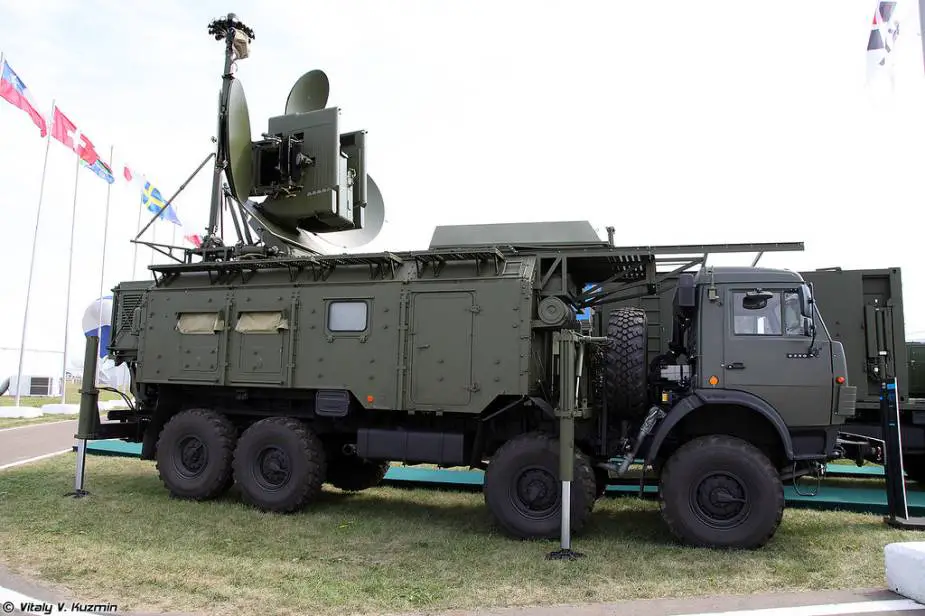Russian Electronic Warfare may develop into independent service - Part 1
The Russian defense industry created over two dozen electronic warfare (EW) systems in the past five years which exceed foreign analogues. EW troops switched from traditional jamming to innovative solutions. The share of modern hardware exceeded 70 percent by the end of the year. EW units promote the operations of various arms and types of forces, the Independent Military Review writes.
Follow Army Recognition on Google News at this link

1RL257E Krasukha-4 designed to jam aircraft communications (Picture source: Vitaly Kuzmin)
The Russian armed forces regularly receive EW hardware, including vehicle-carried Lesochek jammer. It exceeds Russian and foreign analogues, as it has a broader operational frequency band and new jamming methods. Lesochek increases protection of vehicles, armor and troops against radio-controlled explosives on the march and stopover. The complex is mobile and can be carried by armor, automobiles and even in a rucksack. Lesochek is resistant to hostile EW and emission-guided weapons.
EW experts mounted small Lesochek jammers on combat hardware at an exercise and created a mobile closed radio zone. They prevented a drone attack with a grenade mockup and neutralized remotely controlled mines along the route of a column. The tactic was developed according to the latest combat experience.
Palantin tactical EW system has already been supplied to the troops to jam existing and prospective radio communications and engage in electronic reconnaissance. It can blind the adversary in short and ultra-short bands and strip it of cellular and trunk communications. The system unites various EW and reconnaissance units into a single network to increase their effectiveness. The designers introduced decision-making support system. The optimal mission algorithm is created without human interference and the load on each vehicle is automatically distributed. The equipment is carried by four-axis Kamaz trucks.
EW has often to interact with radars to neutralize drones. Radar units detect the targets at minimal and medium altitudes and transmit the data to EW complexes. Borisoglbesk-2 EW complex prevents drone attacks. It detects drone control signals in a range of over 30 km. The signals are used to determine the coordinates of attacking drones. Borisoglebsk-2 also jams satellite communications.
A large number of various EW weapons, including Zhitel and Krasukha, made it necessary to interface them. Pole-21 jammers are included into the defense of important facilities. Pole-21 is integrated into on-duty EW forces comprising Borisoglebsk-2. Pole-21 creates a total controlled field of disturbances for space navigation systems.
The troops will receive Bylina RB-109A complex by 2025. It is controlled by artificial intelligence and can detect and classify targets, determine the hardware to jam communications and other electronic means.
Bylina is carried by five trucks and automatically connects with the headquarters, command posts, EW stations after deployment and identifies radio stations, communication systems, radars, AEW aircraft, satellites and low-power radio stations of subversion groups.
EW weapons have specialized functions. Divnomorye jams radars and onboard electronic devices of airplanes, helicopters, drones, AEW aircraft and protects facilities in a radius of several hundred kilometers against electronic reconnaissance.
Murmansk-BN jams communication and command channels in a radius of 8 thousand km and disrupts communications of aerodynamic targets with adversary headquarters.
Moskva, Krasukha-2 and Krasukha-4 fight air radars, communications and information transmission. Together they create a jammer for all aircraft. Moskva detects and determines the type of adversary EW. Krasukha-2 jams AEW aircraft and Krasukha-4 jams all other aircraft.
© Copyright 2020 TASS / Army Recognition Group SPRL. All rights reserved. This material may not be published, broadcast, rewritten or redistributed.


























